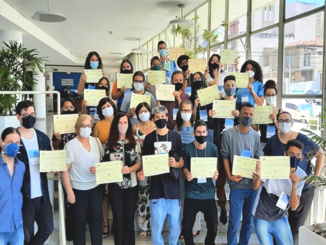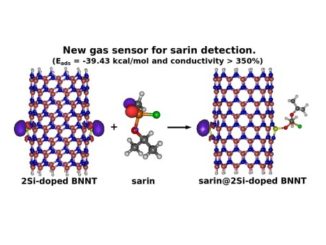
Pesquisadores do Centro de Desenvolvimento de Materiais Funcionais (CDMF) encerraram nesta quinta-feira (29) suas participações na XX Brazil MRS Meeting, promovida anualmente pela Sociedade Brasileira de Pesquisa em Materiais (SBPMat), realizada em Foz do Iguaçu, entre os dias 25 a 29 de setembro.
Confira alguns dos trabalhos apresentados nas sessões de pôsteres durante o evento:
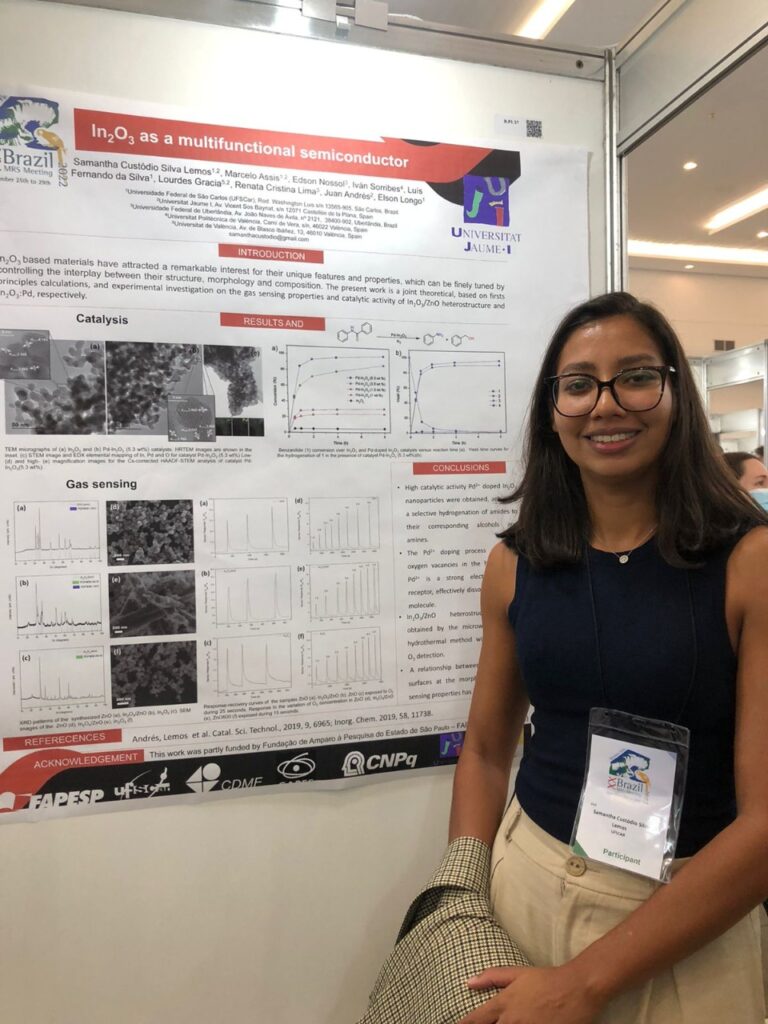
Samantha Custódio – In2O3 as a multifunctional semiconductor
Abstract: In2O3 based materials have attracted a remarkable interest for their unique features and multi-functional properties, which can be finely tuned by controlling the interplay between their structure, morphology and composition. A detailed insight into chemical/physical properties by using advanced experimental techniques and first principle calculations provide significant advantages from both a fundamental and an applicative point of view. The present work presents an analysis of the influence of the insertion of different metal cations in the structural and electronic features of In2O3 to elucidate how these modifications directly affected the material properties and as consequence the activity towards different applications.
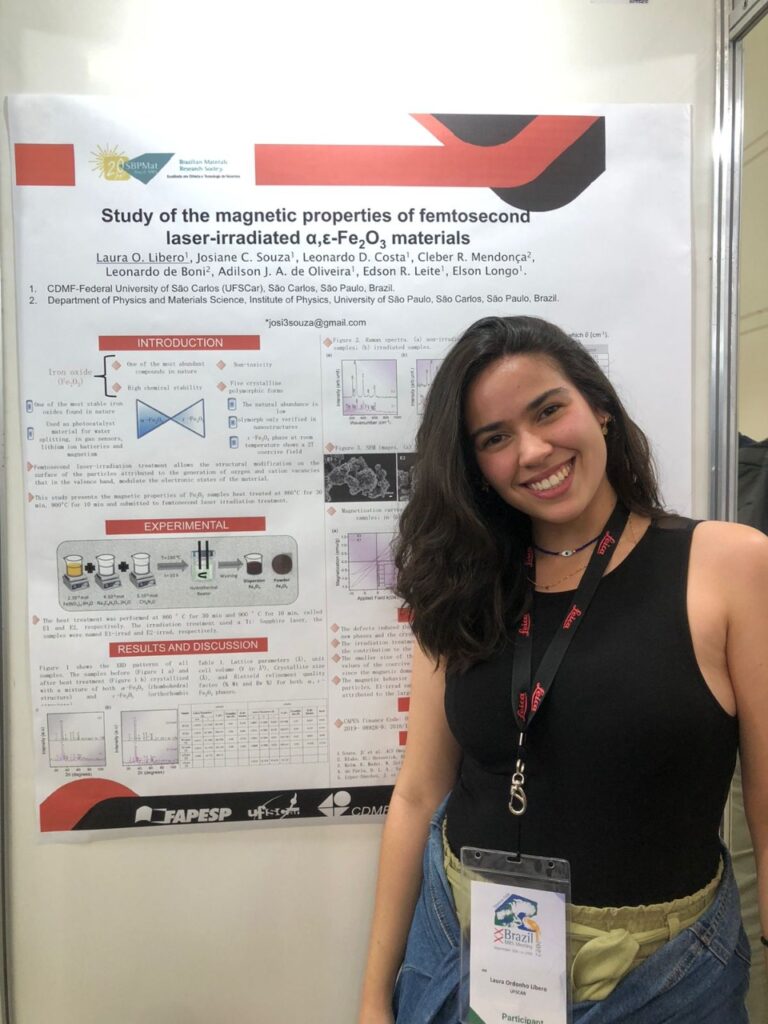
Laura Líbero – Study of the magnetic properties of femtosecond laser-irradiated α,ε-Fe2O3 materials
Abstract: Hematite (α-Fe2O3) and ε-Fe2O3 phases show interesting magnetic properties, so much so that the ε-Fe2O3 phase at room temperature shows a 2T coercive field[1]. Materials obtained by mixing these phases by the hydrothermal process, after heat-treatment (860-900ºC) and femtosecond laser-irradiated showed better performance in their magnetic properties, with a strong ferromagnetic behavior in relation to non-irradiated samples. Samples heated at 900ºC for 10 min and irradiated showed a coercive field greater than six times when compared to non-irradiated samples, respectively, attributed to the increase in defect density, as observed by the absence of active vibrational modes in Raman. The magnetic domain wall is associated with the coercive fields and the morphology of the samples, because the particles of the irradiated samples presented smaller size than the non-irradiated samples. The irradiation treatment induces the ferromagnetic behavior of the samples and the defects generated led to the formation of magnetic moments, without introducing significant stresses in the crystal lattice. The magnetic behavior was dependent on the morphology, defects. The E1-irrad sample showed great potential for application in magnetic components, attributed to the largest amount of the ε-Fe2O3 phase[2].
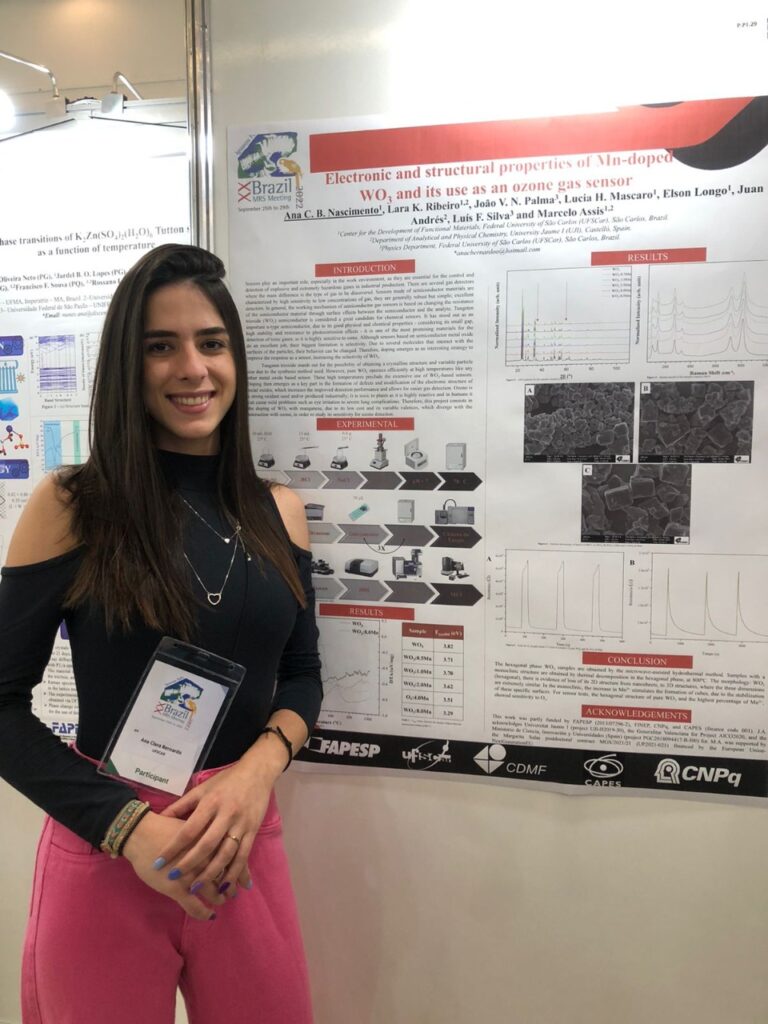
Ana Clara Bernardo – Electronic and structural properties of Mn-doped WO3 and its use as an ozone gas sensor
Abstract: Semiconductor sensors can be successfully used to detect oxidizing gases, such as ozone (O3). Among the semiconductor materials studied, WO3 stands out for the possibility of obtaining a crystalline structure and variable particle size due to the synthesis method used. There are works in the literature that bring the use of expensive metals such as Au, Ag, Pt and Pd, however, the high cost of noble metals reduces the potential for application of this strategy. In this work, samples of WO3:Mn (1, 2, 4 and 8% mol) were synthesized using the coprecipitation method followed by microwave hydrothermal treatment, and calcined at 800°C in a conventional oven. These samples were analysed by XRD, Raman, FTIR, XRD and SEM. Through XRD, Raman and FTIR analysis, it can be observed that all samples obtained correspond to WO3 with orthorhombic phase, without the formation of undesirable secondary phases. Through SEM analysis, it was observed that with increasing Mn concentration in the crystal lattice, the morphology of WO3 changed from irregular polygons to cubes, showing that Mn acts on the surface energies of the WO3 crystals obtained. For the O3 gas sensitivity test, it was observed that the WO3 sample doped with 8% Mn presented a sensitivity 4 times greater than the pure sample.
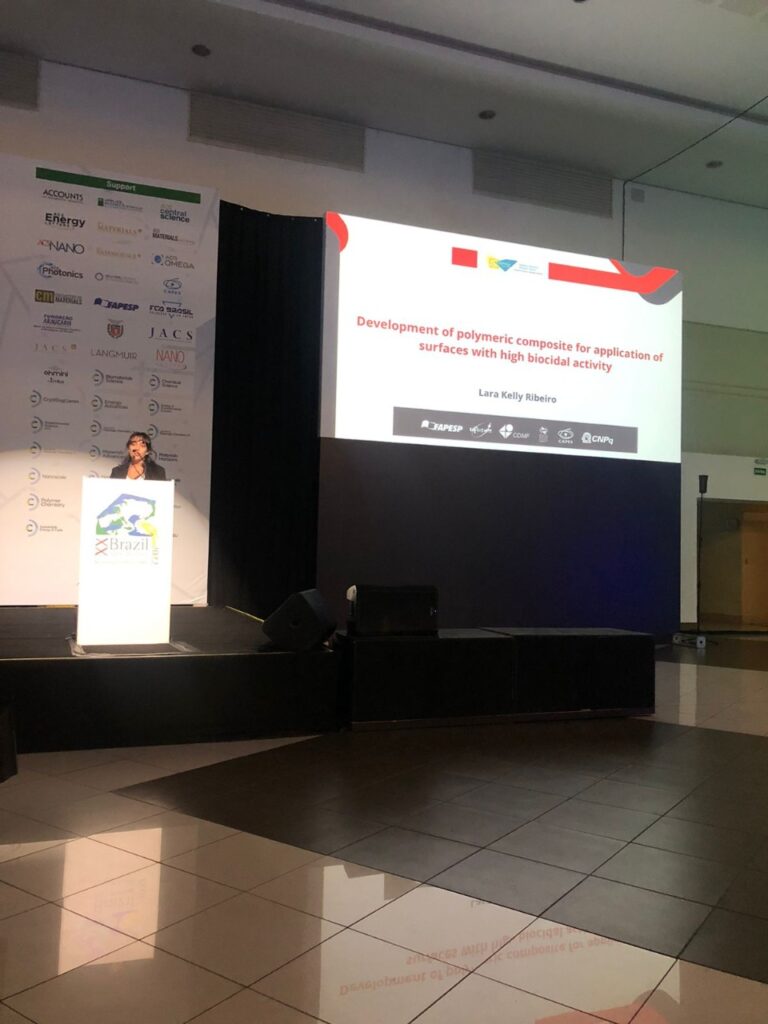
Lara Kelly Ribeiro – Development of Polymeric composite for application of surfaces with high biocidal activity
Abstract: In the scenario of SARS-CoV-2 infections, surface contamination has been the subject of much debate as the biggest cause of transmission of COVID-19. The technological challenge of this work lies in the development of economically viable biocidal systems capable of inactivating various opportunistic pathogens, thus reducing the risk of surface transmission. In this work it is proposed to obtain polypropylene composites, a polymer widely used in several market segments, with the semiconductor (Ag3PO4) with a high biocidal activity. For the development of this work, polymeric composites were obtained, via molten-state, from the mixtures of polypropylene polymer (PP) and semiconductors aiming their technological applications. The polymeric composites were evaluated structurally and morphologically, obtaining correlations between their biocidal activity and their structure. The biocidal activities of polymeric composites were proposed against gram-positive (Staphylococcus aureus) and gram-negative (Escherichia coli) bacteria, against fungi (Candida albicans) and against SARS-CoV-2 virus models. As a product of this research, it is proposed to make polymeric composites for the production of safe biocidal surfaces, which can be applied in personal protective equipment (PPE), food packaging, fabrics (such as masks and aprons), and other devices economically viable to fight against the increase of contamination by surfaces associated with viruses, bacteria and fungi.
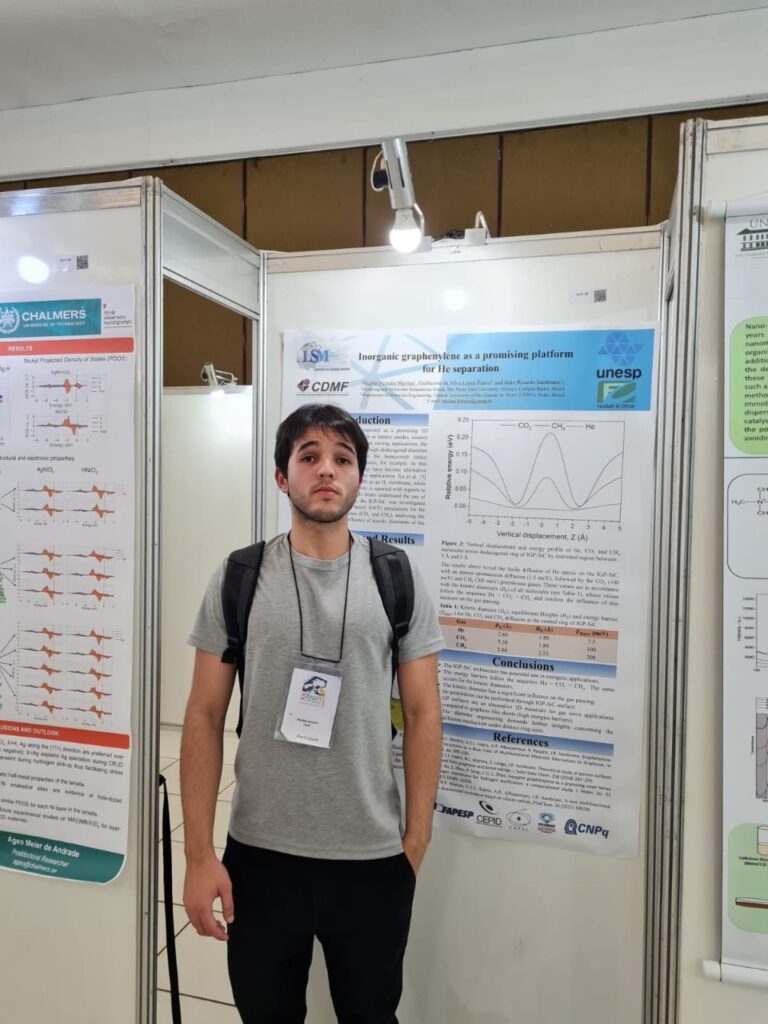
Nicolas Martins – The detection activity of Mn-doped SiC monolayer for CO and CO2 gases: A DFT approach
Abstract: The inorganic graphenylene-like silicon carbide (IGP-SiC) has been proposed recently by Martins et al. [1], which demonstrates the multifunctionality of this 2D material in different services and exploring the influence of Fe doping on the SiC surface for sensor applications. In this sense, the present theoretical study investigates the doped IGP-SiC with manganese in view of analyzes the acting of the transition metal on the adsorption mechanism for CO and CO2 molecules. The DFT simulations performed reveals the band gap decreasing on the Mn-IGP in comparison to IGP-SiC with an indirect-direct gap transition, and the increase on gases interaction by the negative adsorption energies for CO (-0.80 eV) and CO2 (-0.81 eV), that indicates the presence of physisorption. In addition, the recovery times is 33.9s and 50s at 298 K for CO and CO2, respectively, which suggest the great potential of Mn-IGP detects these gases in the industrial ambience.
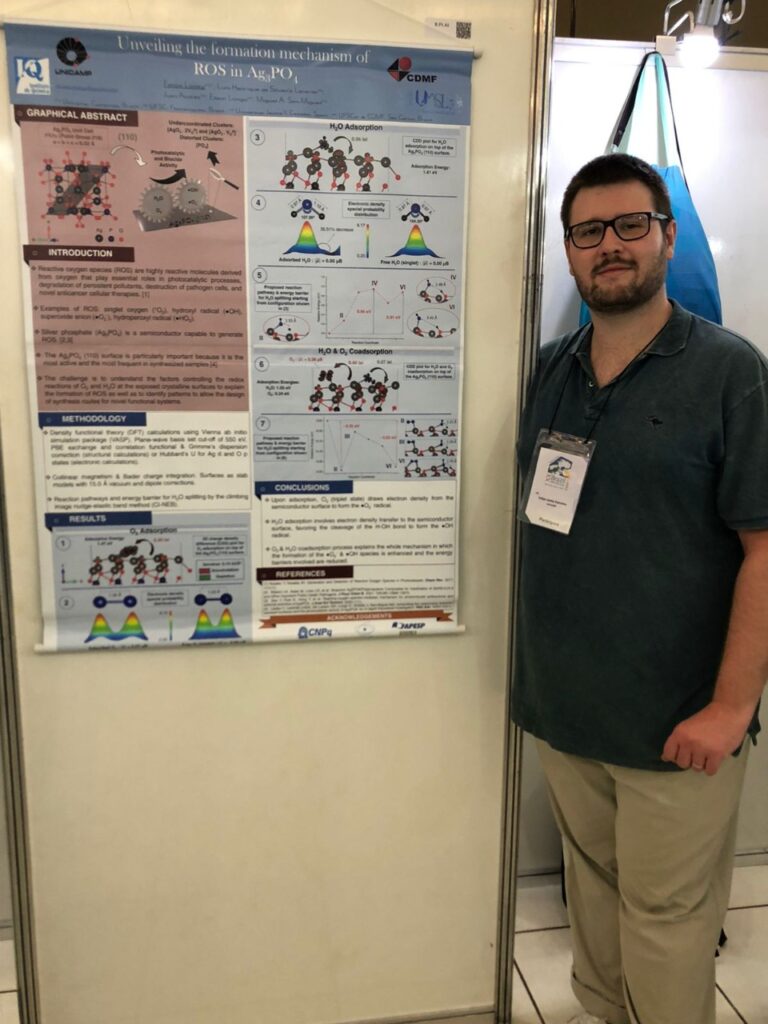
Felipe Lipsky – Unveiling the mechanism to form ROS in Ag3PO4
Abstract: The formation of reactive oxygen species (ROS) over the semiconductor surfaces is a topic of tremendous scientific attention owing to their essential role in photocatalytic and biological processes. Density functional theory (DFT) calculations are used to disclose the photocatalytic and biocide activity at the (110) surface of Ag33PO4 1,2. A new chemical mechanism was proposed using a tandem couple of molecular oxygen (O2) and water (H2O) molecules, leading to the formation of superoxide (●O2-) and hydroxyl (●OH) radicals, respectively. Furthermore, this result provides a rational molecular design as the universal principle to explain the activity of semiconductors. This study represents a novel contribution to the literature to scrutinize the surface properties of semiconductors to a more precise level and devise ideal exposed surfaces at the morphology for the intended production of ROS in regulating the O2 and H2O activation.
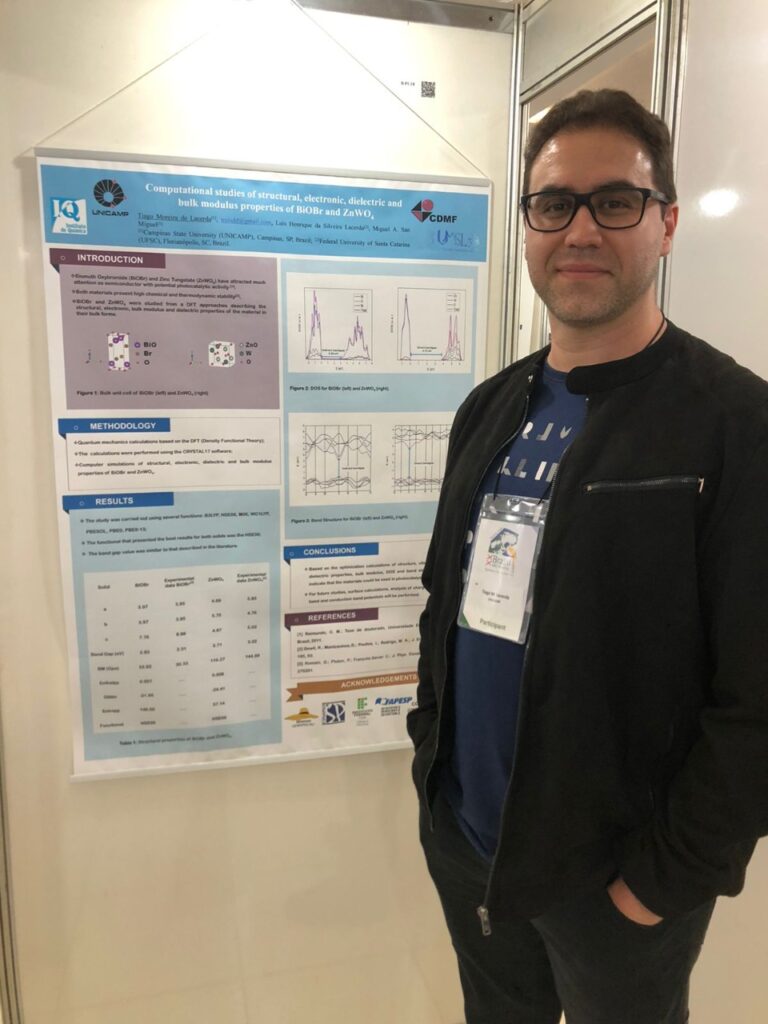
Tiago Moreira de Lacerda – Computational studies of structural, electronic, dielectric and bulk modulus properties of BiOBr and ZnWO4
Abstract: Bismuth Oxybromide (BiOBr) and Zinc Tungstate (ZnWO4) has attracted great attention as a semiconductor with great photocatalytic potential due to its high chemical stability and hierarchical structure. In this work, BiOBr and ZnWO4was studied from a DFT approach, presenting descriptions of the structural, electronic, bulk modulus and dielectric properties of the material in its bulk form. The results obtained show that the structures of BiOBr and ZnWO4studied provide an interesting insight on surface properties that could have applications related to photocatalysis and can be used in the degradation of a variety of organic pollutants.
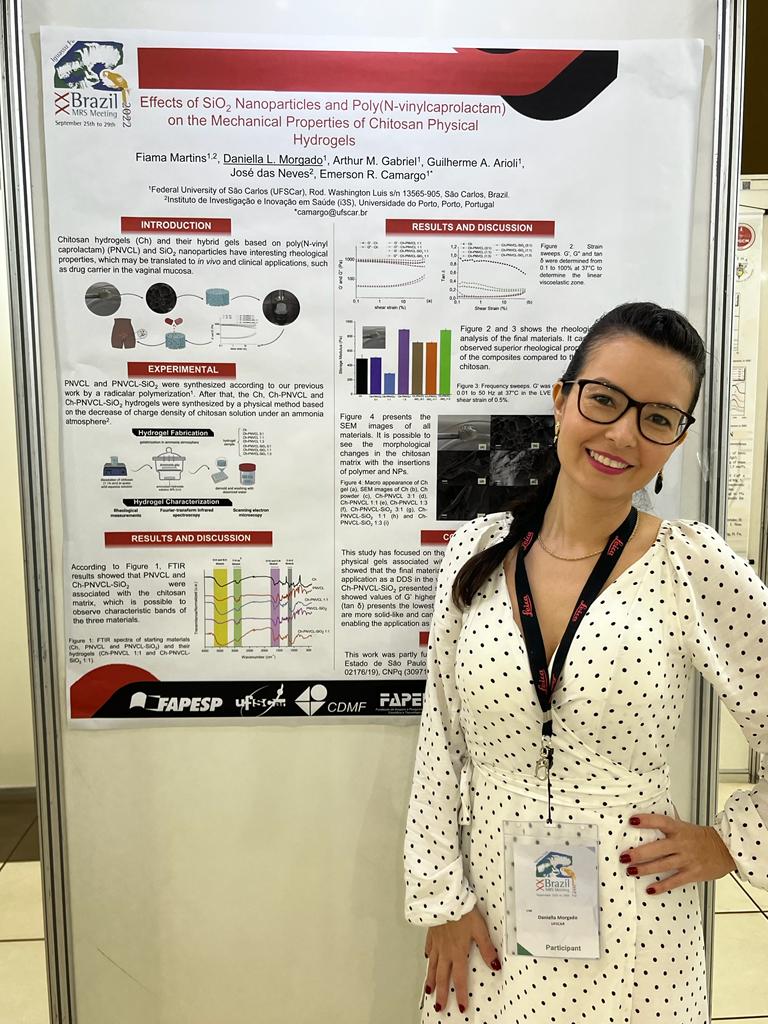
Daniella Morgado – Effects of SiO2 Nanoparticles and Poly(N-vinyl caprolactam) on the Mechanical Properties of Chitosan Physical Hydrogels
Abstract: Chitosan (Ch) and poly(N-vinylcaprolactam) (PNVCL) present a great potential for biomedical applications as drug delivery systems. It is known that Ch-based materials can provide potential advantages in biomedical applications. PNVCL is a polymer that presents biocompatibility in vitro and in vivo and exhibits a lower critical solution temperature (LCST) phase transition1. The insertion of nanoparticles in the polymer system can improve the mechanical properties and provide better interactions between the polymer and molecules. In this study, pure Ch, PNVCL-Ch and PNVCL-SiO2-Ch hydrogels were fully characterized. We observed a decrease in the G’ modulus in all PNVCL concentrations compared to the pure Ch hydrogel, which occurred due to a low interaction between the polymer chains of PNVCL and Ch and also due to a difference in polymer size between PNVCL and Ch. On the other hand, the composites Ch-PNVCL-SiO2presented an increase in storage modulus when the concentration of PNVCL-SiO2was three times of the Ch. These results could most likely be explained by the particle reinforcement of SiO2nanoparticles bound to the PNVCL. The results obtained for these hydrogels also show that the mechanical properties can be modulated according to the application. We believe that the composite Ch-PNVCL-SiO2can be optimized for topical drug delivery.
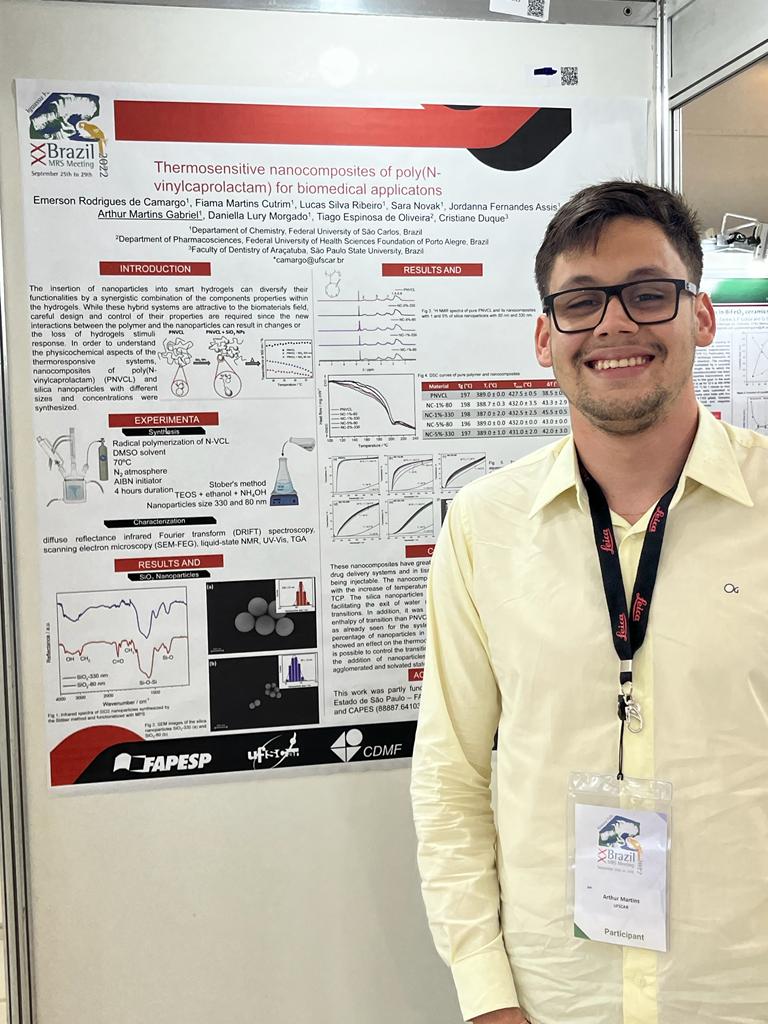
Arthur Martins – Thermosensitive nanocomposites of poly(N-vinylcaprolactam) for biomedical applications
Abstract: Poly(N-vinylcaprolactam) (PNVCL) is a thermosensitive polymer that presents an excellent biocompatibility in vitro and in vivo and exhibits a lower critical solution temperature (LCST) phase transition1 with great potential for biomedical applications as drug delivery systems. The insertion of different nanoparticles, such as spherical dense or porous SiO2, fibrous SiO2and some functionalized oxide resulted in a broad transition temperature due kinetic effects, but thermodynamic properties were unaffected by the number of nanoparticles inserted. The introductions of nanoparticles of ative bioglass also showed that these hydrogels can be used for bone regeneration scaffolds.. Although pure and modified PNVCL nanocomposites could be efficiently used for the transport and for controlled liberation of several antibiotics and anticancer drugs, some flavonoids were strongly attached to PNVCL molecules, which demanded the combination of this hydrogel with other biomolecules such as chitosan. These blends were evaluated through molecular dynamics simulation, showing that chitosan and PNVCL chains have several groups that forms new hydrogen bonds, which improved their mechanical properties.
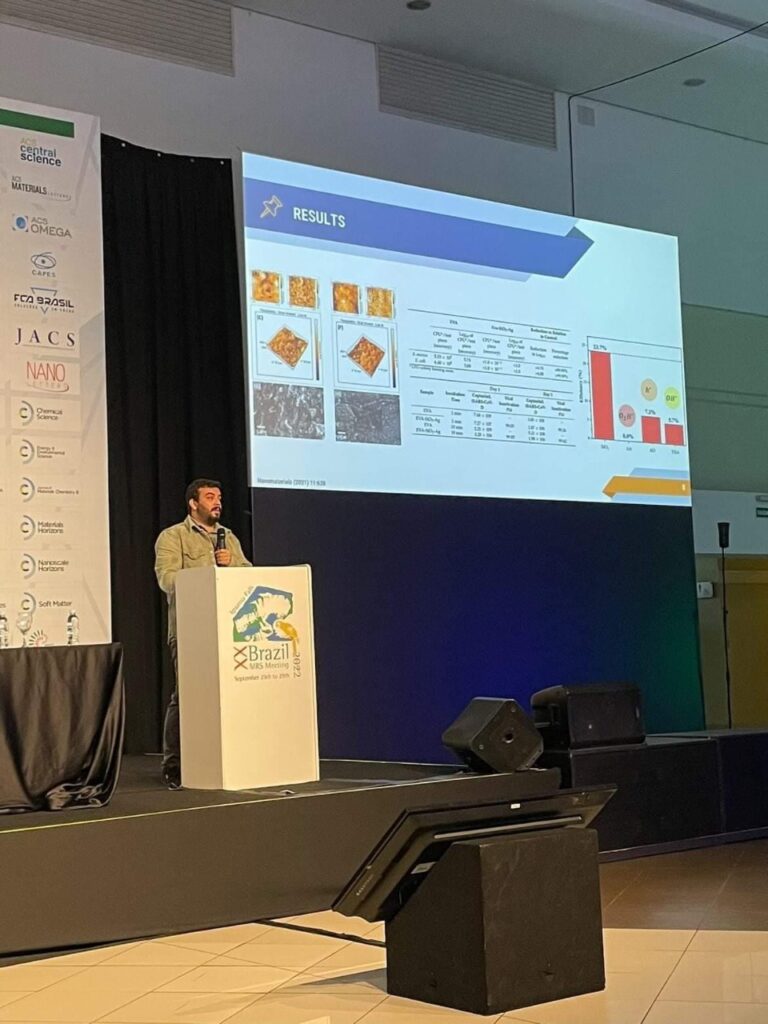
Marcelo de Assis – SiO2:Ag as a powerful additive for obtaining antimicrobial composite materials
Abstract: The worldwide outbreak of the coronavirus pandemic (COVID-19) and other emerging microbial infections have attracted particular interest in the design and development of novel antimicrobial agents with a broad spectrum of activity. In the current scenario of SARS-CoV-2 infections, the technological challenge lies in the development of economically viable, reusable biocidal systems capable of inactivating opportunistic pathogens, thus reducing the risk of infection and transmission. In this work, Ag nanoparticles anchored to amorphous SiO2were developed in order to improve the dispersion and stability of Ag nanoparticles. This structure was immobilized in different polymers, such as ethylvinyl acetate (EVA) and polyvinyl chloride (PVC), and its structural and antimicrobial properties were studied and correlated. Antimicrobial tests were performed against bacteria (S. aureusand E. coli), fungi (C. albicansand P. funiculosum) and the SARS-CoV-2 virus, eliminating these pathogens above 99%. In this sense, the SiO2:Ag heterostructure can be considered an effective antimicrobial additive for the development of new antimicrobial polymeric technologies.
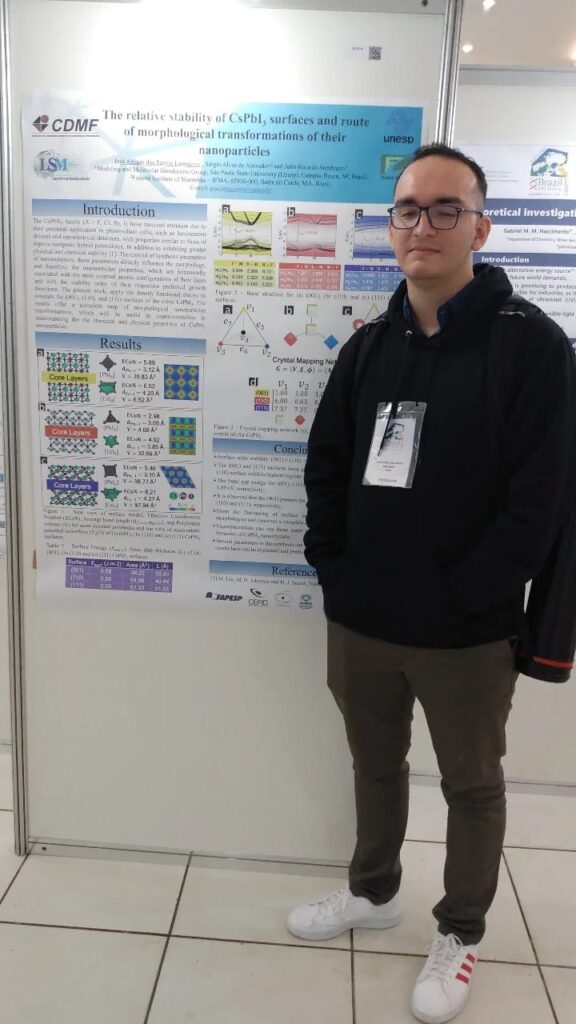
Jose Artigas Laranjeira – The relative stability of CsPbI3 surfaces and route of morphological transformations of their nanoparticles
Abstract: The CsPbX3 family (X = F, Cl, Br, I) have received attention due to their potential application in photovoltaic cells, such as luminescent devices and optoelectrical detectors, with properties similar to those of organic-inorganic hybrid perovskites, in addition to exhibiting greater physical and chemical stability [1]. In this context, the control of parameters in the synthesis of nanomaterials has attracted attention in recent years, as it is known that these parameters directly influence the morphology, and therefore, the properties of nanoparticles, which are intrinsically associated with the most external atomic configurations of their faces and with the stability order of their respective preferred growth directions. However, the detailed knowledge of these configurations is not easily determined but can be studied through computational methods. In this way, in the present work, the density functional theory (DFT) is applied to simulate the (001), (110), and (111) surfaces of the cubic CsPbI3. The results offer a complete map of morphological nanoparticles transformations, which will be useful to experimentalists in understanding the relationship between the chemical and physical properties of CsPbI3 nanoparticles. Symmetrical and non-stoichiometric surface models will be simulated, and the most stable terminations for each surface are determined. The results indicate the following order of stability (001) [0.22 J m-2] >(111) [0.63 J m-2] >(110) [0.75 J m-2], surface energy values (E_surf) are in square brackets.
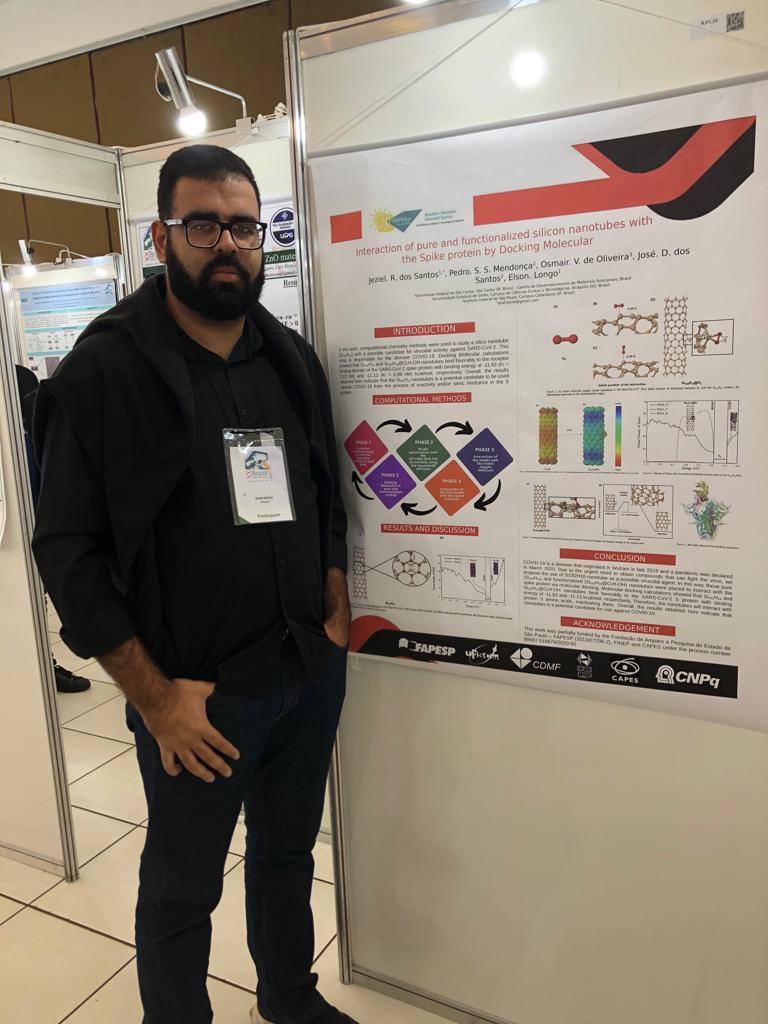
Jeziel Rodrigues – Interaction of pure and functionalized silicon nanotubes with the Spike protein via Docking Molecular
Abstract: In this work, computational chemistry methods were used to study a silicon nanotube (Si192H16) with a possible candidate for virucidal activity against SARS-CoV-2. This virus is responsible for the disease COVID-19. Docking Molecular calculations showed that Si192H16 and Si192H16@O2H-OH nanotubes bind favorably to the receptor binding domain of the SARS-CoV-2 spike protein with binding energy of -11.83 (Ki = 2.13 nM) and -11.13 (Ki = 6.99 nM) kcal/mol, respectively. Overall, the results obtained here indicate that the Si192H16 nanotubes is a potential candidate to be used against COVID-19 from the process of reactivity and/or steric hindrance in the S protein.
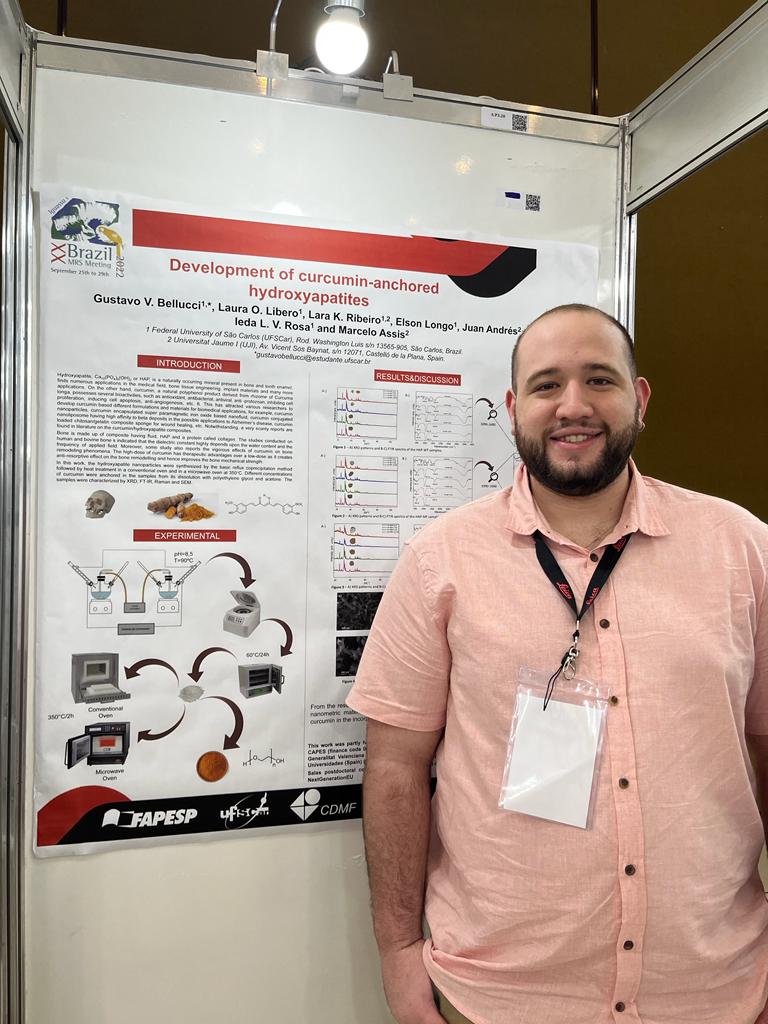
Gustavo Bellucci – Development of curcumin-anchored hydroxyapatites
Abstract: Hydroxyapatite, Ca10(PO4)6(OH)2 or HAP, is a naturally occurring mineral present in bone and tooth enamel, finds numerous applications in the medical field, bone tissue engineering, implant materials, thin layer chromatography and protein chromatography and many more applications. On the other hand, curcumin, a natural polyphenol product derived from rhizome of Curcuma longa, possesses several bioactivities, such as antioxidant, antibacterial, antiviral, anti -protozoan, inhibiting cell proliferation, inducing cell apoptosis, anti-angiogenesis, etc. This has attracted various researchers to develop curcumin based different formulations and materials for biomedical applications, for example, curcumin nanoparticles, curcumin encapsulated super paramagnetic iron oxide based nanofluid, curcumin conjugated nanoliposome having high affinity to beta deposits in the possible applications to Alzheimer’s disease, curcumin loaded chitosan/gelatin composite sponge for wound healing, etc. Notwithstanding, a very scanty reports are found in literature on the curcumin/hydroxyapatite composites. Bone is made up of composite having fluid, HAP and a protein called collagen. The studies conducted on human and bovine bone s indicated that the dielectric constant highly depends upon the water content and the frequency of applied field. Moreover, some study also reports the vigorous effects of curcumin on bone remodeling phenomena. The high-dose of curcumin has therapeutic advantages over a low-dose as it creates anti-resorptive effect on the bone remodelling and hence improves the bone mechanical strength. In this work, the hydroxyapatite nanoparticles were synthesized by the basic reflux coprecipitation method followed by heat treatment in a conventional oven and in a microwave oven at 350°C. Different concentrations of curcumin were anchored in the samples from its dissolution with polyethylene glycol and acetone. The samples were characterized by XRD, FT-IR, Raman and SEM.
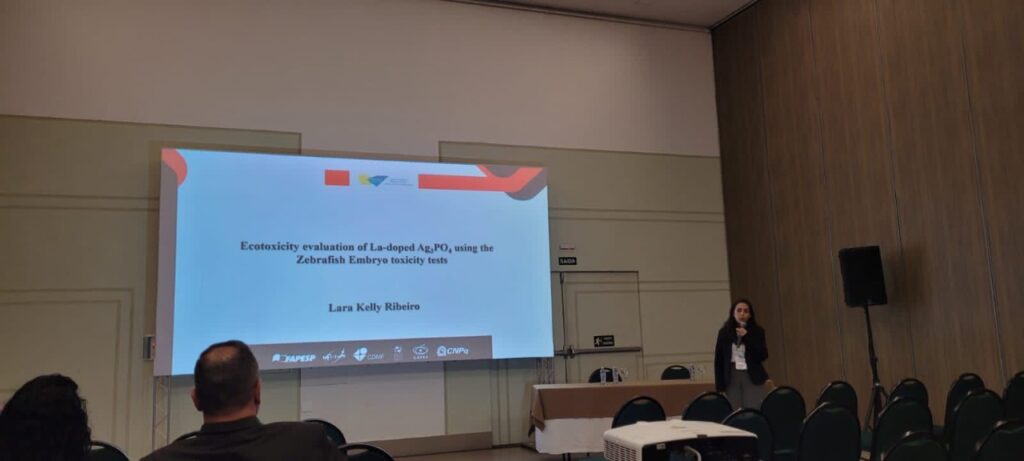
Lara Kelly Ribeiro – Ecotoxicity evaluation of La-doped Ag3PO4 using the Zebrafish Embryo toxicity tests
Abstract: The main sources of water pollution are the inappropriate disposal and treatment of chemical residues, which damage aquatic ecosystems and increase risks to human health. The degradation of organic pollutants is a chemical process that involves the breakdown of larger molecules into smaller and less polluting molecules. The search for photocatalysts with high performance in the visible light region has been prioritized, since this approach is more sustainable because it takes advantage of the energy wealth available in sunlight. An example that has been widely studied in aquatic ecosystems is the photocatalytic process that occurs due to the presence of a semiconductor. Among the semiconductor materials, silver phosphate (Ag3PO4) has shown superior performance in photocatalytic processes aimed at the degradation of organic pollutants under visible light irradiation. Given the importance of Ag3PO4 in the environmental scenario, this research aims to carry out toxicological tests to enable the use of this semiconductor doped with rare earth materials (in the case of La+3) in aquatic ecosystems. Present findings confirm that Zebrafish and mammal toxicity profiles are strikingly similar, and Zebrafish’s transparency and short life cycle allow direct in vivo assessment of Ag3PO4:La toxicity.
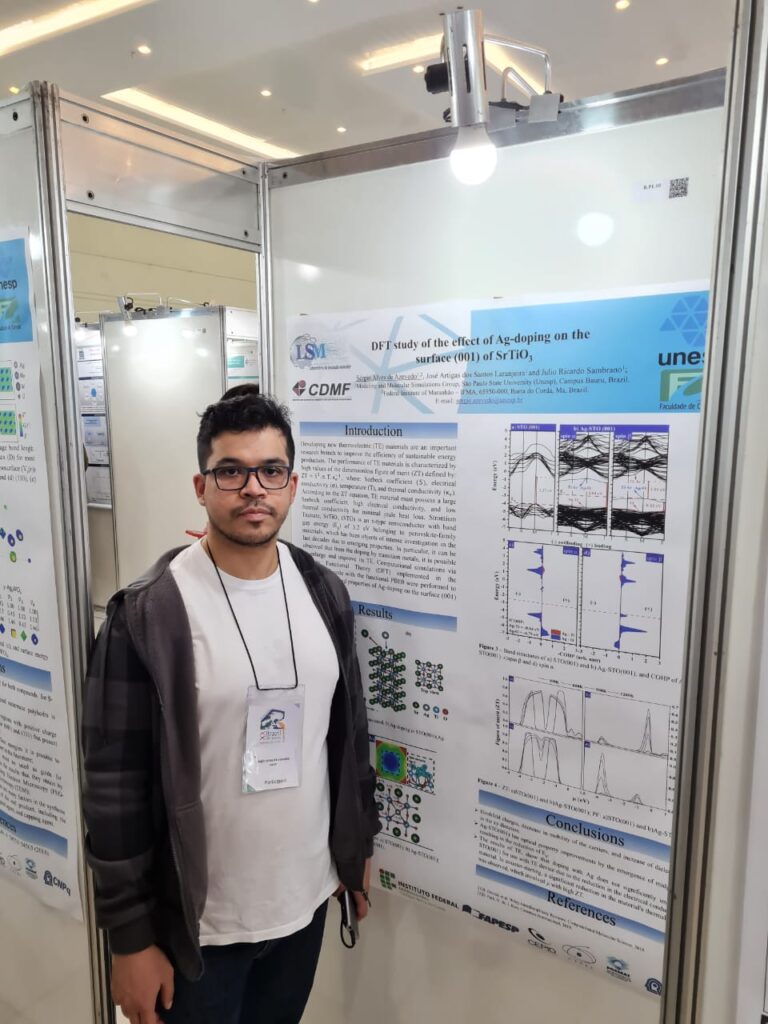
Sergio Alves de Azevedo – DFT study of the effect of Ag-doping in surface (001) of SrTiO3
Abstract: Computational simulations via Density Functional Theory (DFT) implemented in the Crystal17[1]code with the functional PBE0 were performed to study the effect and properties of Ag-doping on the surface (001) of SrTiO3 . The SrO termination had the lowest surface energy with an indirect band gap of 3.27 eV and a changer of Hirshfeld of Sr +1.83, Ti +2.39, and O -1.47. The Ag-doping reduced the energy of the band gap to spin α = 2.84 and β = 2.01 eV with the presence of unpaired electrons in the valence band (VB). Furthermore, the Richfield charge shows p-type doping by reducing the charge of the metallic species and increasing O atoms (Ag +0.92, Sr +1.75, Ti +2.19, and O -1.19). The result of the Crystal Orbital Hamilton Population (COHP) shows bonding (Ag-O) at a maximum of VB and minimum of the conduction band (BC), the COHP integral (ICOHP) shows that the bonding (Ag-O) is the most strong (ICOHP = -4.79 eV). The results of transport properties showed Ag-doping to increase the Seebeck coefficient and reduce electrical conductivity. In contrast, it reduces the thermal conductivity, which results in the ZT increment, similar to the experimental result[2]. Therefore, Ag-doping reduces band gap energy, indicating functional material for photocatalysis or optical devices in the UV-Vis region. Possible doping with Ag can improve thermoelectric properties.

Laura Líbero – Development of FeMoO4 supported on chiloson as heterogeneous Fenton catalyst for sulfide oxidation
Abstract: The continuous search for clean fuels motivates the development of functional materials for transformations of unwanted compounds. On this matter, nanomaterials can be designed as an efficient and low-cost catalysts applied in sulfide oxidation reactions. Heterogeneous Fenton-like reactions has gained much attention, due to the potential to generate oxidative species from “greener” oxidant, such as H2O2.[1] The main challenge considering the oxidation of sulfide is the production of sulfones from sulfoxide which requires radical conditions of temperature and great amount of toxic oxidants.[2] In this project, the iron molybdate was synthesized by hydrothermal microwave assisted method, once iron is an abundant element and economically viable compound. In addition, it was incorporated into the polymeric matrix in different concentrations. The catalytic potential was evaluated by yield and ratio of conversion to sulfone, using thianisole as a standard sulfide molecule. The sample’s structural was analysed by X-Ray Diffraction, Raman Spectroscopy and UV-Vis Spectroscopy. The morphological analysis, by Scattering Electronic Microscopy and AFM. In conclusion, the catalytic pre-determined parameters were optimized. The scavengers test provided information about the mechanism of reaction, as well as the scope.
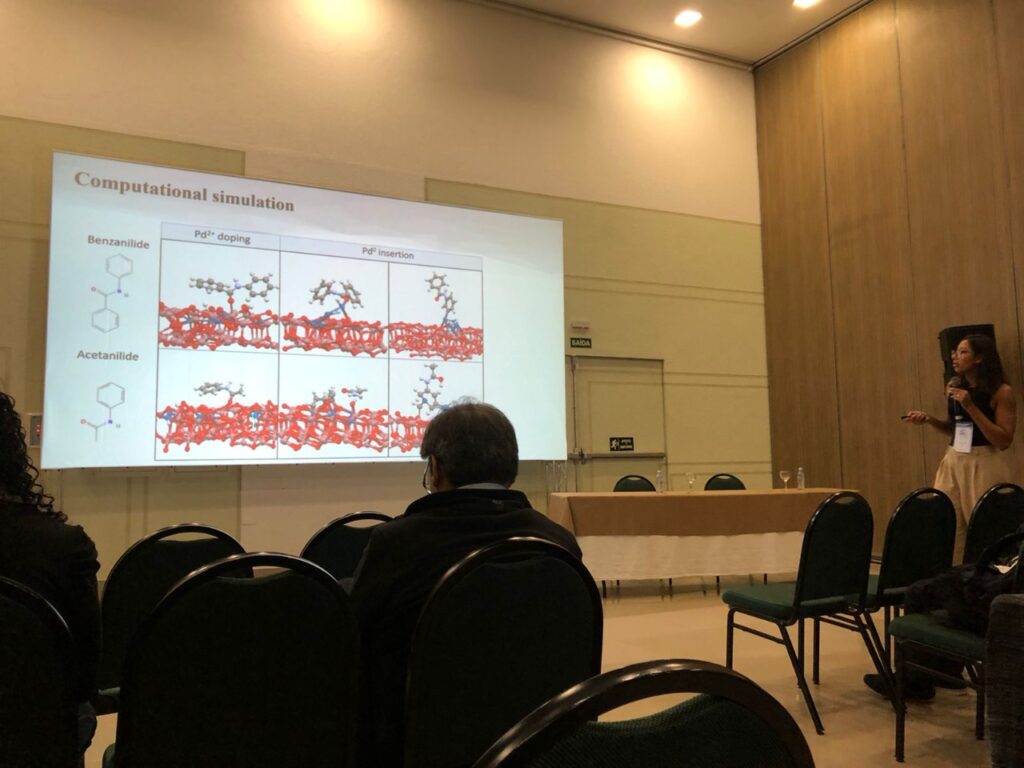
Samantha Custódio – Catalyst functionalization for hydrogenation reactions: the role of Pd species in In2O3 surface
Abstract: Interesting catalytic activity for hydrogenation reactions have been reported for In2O3 nanoparticles. The lack of proposed mechanisms of this reaction over solid surfaces difficult the comprehension of the crucial aspects involved and consequently retard the development of effective catalysts. In the present work, the analysis of the insertion of Pd atoms in the In2O3(111) surface was carried out within the periodic DFT framework. The relationship between surface structure (active sites and charge distribution) and performance was investigated considering the H2 adsorption and dissociated atomic H energies over the built slabs. To provide insights into the mechanism, aromatic amides were selected, and the findings allows us to disclose the role, at atomic level, of Pd2+and Pd0 configurations in achieving effective and selective conversion.
CDMF
O CDMF é um dos Centros de Pesquisa, Inovação e Difusão (Cepids) apoiados pela Fundação de Amparo à Pesquisa do Estado de São Paulo (Fapesp), e recebe também investimento do Conselho Nacional de Desenvolvimento Científico e Tecnológico (CNPq), a partir do Instituto Nacional de Ciência e Tecnologia dos Materiais em Nanotecnologia (INCTMN).



